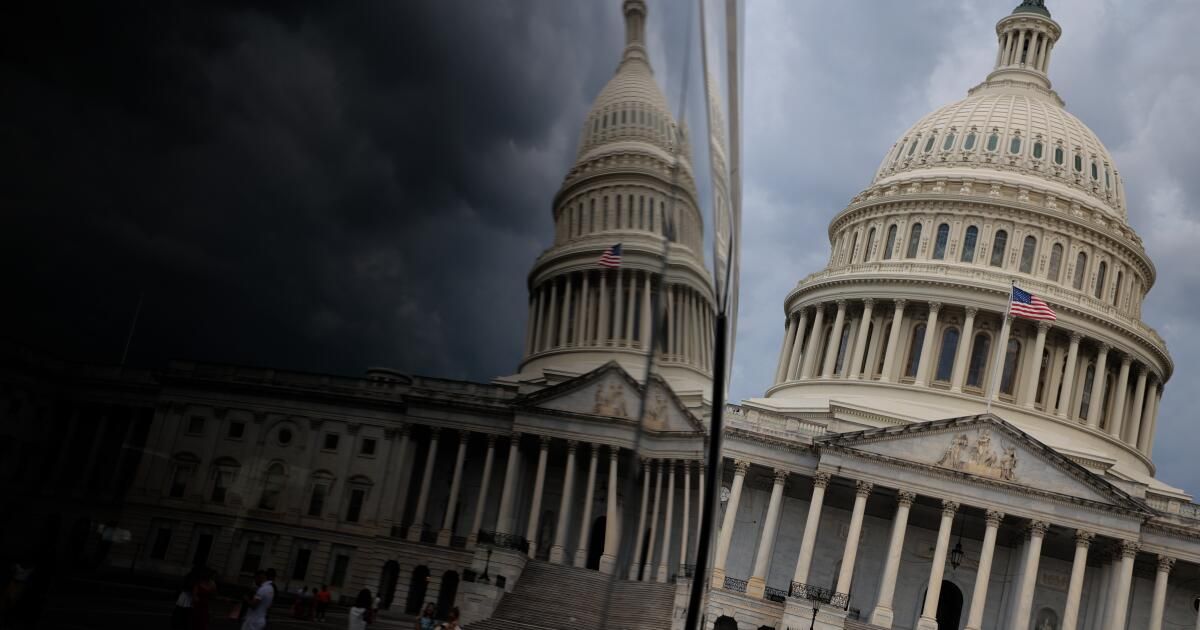Here we go again. This week, the Senate presented, perfected and approved its version of the “Great Beautiful Bill,” and is a fiscal monstrosity. What was already a large disaster in the house has been overcome at an ode of $ 4 billion for the lack of bush.
This is not a tax reform. It is a bipartisan piñata full of pork, tricks and, of course, debt. They tell us that we encourage because the bill makes some policies permanent in favor of growth, including 100% bonus depreciation and R& + D. expenses, however, some pearls in a vast ocean of bad policies are nothing to celebrate. It's like marveling at newly painted rooms in a house on fire.
We have told us that we encourage because the bill eliminates or cuts $ 147 billion of the worst brochures of the camera version. But as Arnold Ventures analysis pointThe Senate also added $ 186 billion to the pot. That's a network increase of $ 39 billion in pork.
This is what Washington calls compromise: the Chamber proposes $ 1, the Senate proposes $ 2 and somehow ends up spending $ 3. Congress is managing both to break the bank and violate its own budget rules.
With $ 3.2 billion in direct costs and $ 700 billion in interest payments, the budget proposal would carry a total of total loans to $ 3.9 billion, according to a Previous analysis by the Congress Budget Office. President Biden took four years to add $ 4.7 billion to the deficit.
Do not ignore the baked cynicism in this bill. It rises to the limit of the state and local tax, or salt, the deduction (known as a blessing for the rich) to $ 40,000 (with a “gradual elimination” in 2029 that no one believes that it will happen). There are hundreds of thousands of millions in “temporary” provisions that everyone knows that they will extend. There is an impact of deficit so large that even the most pink dynamic scores cannot make the numbers join.
This bill also violates the Chamber's own instructions for the reconciliation of the budget, which recommend $ 2 billion in expenses compensation. The version of the house fell somewhat short, combining $ 3.8 billion in tax disgrade with cuts of $ 1.6 billion. The version of the Senate? Almost $ 4.5 billion in tax cuts and only $ 1.4 billion in expenses reductions: a violation of $ 600 billion legislators allegedly agreed.
The Republicans once spoke seriously about the alignment of taxes and expenses. They worried about economic distortion, simplicity and extension of the tax base. Now, many just want the sugar avalanche of tax cuts without fiscal discipline. Meanwhile, the Democrats want to greatly expand the State and pretend that billionaires can only pay the bill. Both parties are wrong. Mathematics does not work, and the morality of reckless spending is worse.
Those who wish to frame this bill as a growth in favor of dreams. They trust unrealistic economic assumptions about a short -term increase to justify the consequences of long -term debt increases, and the banking discharges of cost disc that nobody takes seriously.
The reality is quite different. My colleague Jack Salmon calculates that if he takes all pro-decrease growth provisions, he obtains approximately 1% of additional growth, but is literally canceled by the degradation produced by the extent of the salt cover.
Unfortunately, the generosity fed by debt can generally be sold with the magic phrase of “tax cuts”. To be clear, tax cuts are generally excellent whenever Congress reduces spending. The Tax Code is intended to increase the necessary income to finance the government that Americans claim to desire. If we decide that under any circumstance they should not cut the expense, then we do not deserve tax cuts.
I break my heart say this, because my desire is a significantly smaller government, with less debt and lower taxes. People who have followed my work know that all subsidies would end private companies. It would return education and many other functions to states and also end most of the subsidies. It would radically measure the benefits of proof rights and much more. Well -designed expenses are a proven way to reduce debt / GDP ratio. They are the responsible path to the lowest taxes.
But I will not tolerate a system that spends greatly in our generation and sends the bill to future generations, waiting for them to occupy the debt and inflation crisis that will result. If Americans want a large government, we have to pay it with higher taxes now and deal with the most slow growth punishment.
Legislation is a means by which politicians point out their priorities. For now, it is clear that most of them feel comfortable by harming future generations with higher taxes and inflation to consent to current components through billion dollars, corporate gifts, budget rule rapes and dishonest accounting rule. But Americans cannot afford many more “beautiful” offers that are so horribly ugly under the sheet.
Veronique de Rugy He is a senior research member at the Mercatus Center of the George Mason University. This article was produced in collaboration with the creators Syndicate.
Perspectives
Times Insights It offers an analysis generated by the voices content to offer all points of view. Insights does not appear in any news article.
point of view
Perspective
The following content generated by AI works perplexed. Los Angeles Times editorial staff does not create or edit the content.
Ideas expressed in the piece
- The author argues that the “Great Beautiful Law” of the Senate is a “fiscal monstrosity” that prioritizes political convenience on fiscal responsibility, with net increases and budgetary tricks that replace genuine reform.[4].
- Key criticisms include:
- An increase in deficit of $ 3.9 billion ($ 3.2 billion in direct costs + $ 700 billion interest) that violates the rules of the Congress budget, with compensation of expenses that cover only $ 1.4 billion of the $ 4.5 billion in tax cuts in[4].
- Cynical provisions such as raising the salt deduction limit to $ 40,000 (benefiting rich measures) and “temporary” designed for permanent extension, worsening the long -term debt[4].
- The elements in favor of growth are denied by economically harmful policies, resulting in insignificant net growth despite mass loans[4].
- The author concludes that the bill exemplifies the reckless generational theft, using debt to finance current benefits by imposing future inflation and tax burdens[4].
Different views on the subject
- The proponents argue that the bill achieves critical economic and security priorities:
- Make Trump's tax cuts permanent to stimulate investment, together with the expansion of agricultural security networks and increase payment limits to $ 155,000 (inflation indexed)[1][2].
- Assign $ 175 billion for border security, including $ 46.5 billion for the construction of walls and $ 45 billion for detention capacity[2][3].
- Prioritize national interests through the financing of defense and energy production, while cutting social programs considered excessive[1][3].
- Supporters dismiss deficit concerns by emphasizing the dynamic economic growth of fiscal policies and the necessary expenses adjustments, with the Senate leaders who obtain approval to comply with the deadline of July 4.[1][3].
- The inclusion of the legislation of a Rural Hospital Fund of $ 50 billion and reduced asylum rates ($ 100 compared to $ 1,000) reflects specific commitments to address capital concerns[2].












